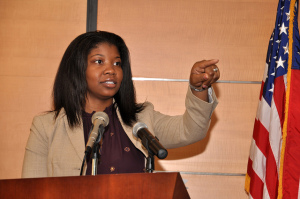Women in power and IPV

Community-level change. We all know it’s important, but what kinds of changes should we make? And how exactly do they affect intimate partner violence (IPV)? Yes, increasing gender equity, changing social norms, increasing access to valuable resources, etc. are part of the solution. But how, precisely?
A new study by M. Pippin Whitaker looked at a variety of county-level factors and tried to figure out how community context affects individual men’s risk factors for perpetrating IPV. She was most interested in how county factors related to gender, such as women’s power and access to resources, affected gender-related risk factors for men, such as hostility toward women and seeking control in intimate relationships. To figure it out, she asked men about their attitudes and IPV perpetration behaviors, as well as what county they were from.
The study was small, and only included South Carolinians in their first year of college, most of whom were white, but its findings were interesting, and worthy of some more research. It measured gender equity in counties in various ways, one of which was called formal power. Formal power in this study was defined as a combination of the proportion of women in law enforcement, the proportion of women in elected offices, and the proportion of women-owned businesses. According to the study, men seeking control in intimate partner relationships was a risk factor for perpetrating IPV. But for every standard deviation increase in women’s formal power, there was a 71% decrease in the risk that control-seeking men would perpetrate physical IPV. In plain English, the more formal power women had in a county, the less likely control-seeking men from that county were to commit physical IPV.
This finding is really interesting, because the way it was measured shows that the community context has direct impacts on individual people’s risk factors for perpetration. Because the study was so small, we really need more research to figure out if this applies in more counties and for more risk factors. But if the finding is applicable to other communities, it would mean that “promoting women’s power in a community in general may protect against IPV.” For instance, practitioners working to “increase the visibility and number of women in powerful positions” in their community could directly affect IPV perpetration. And while making individual-level change, like encouraging men not to seek control over their partners, is clearly important, it’s basically impossible to reach all men individually. This kind of community-level context change is a great way to reduce the risk of IPV for entire communities, without working directly with everyone in the community.
Full citation: Whitaker, M. P. (2014). Linking community protective factors to intimate partner violence perpetration. Violence Against Women, 20(11), 1338-1359. doi:10.1177/1077801214552854
Link: http://vaw.sagepub.com/content/20/11/1338.short
Full abstract:
“This study explores how community factors moderate men’s individual risk for physical and psychological intimate partner violence (IPV) perpetration. The sample of 604 male first-semester undergraduate students supports a connection between county-level protective and risk factors, an individual risk factor, and IPV perpetration. For each unit increase in the proportion of women in powerful positions within a county, there was a 71% decrease in the risk that control-seeking respondents would perpetrate physical IPV, controlling for other factors including population density and violent crime. This article presents a multilevel analysis using hierarchical generalized linear modeling and discusses practice and research implications.”
